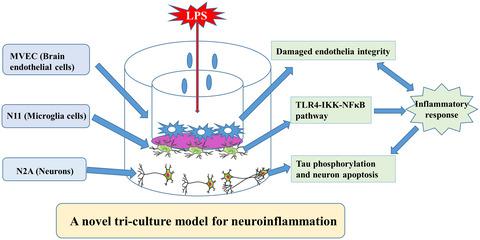当前位置:
X-MOL 学术
›
J. Neurochem.
›
论文详情
Our official English website, www.x-mol.net, welcomes your feedback! (Note: you will need to create a separate account there.)
A novel tri‐culture model for neuroinflammation
Journal of Neurochemistry ( IF 4.7 ) Pub Date : 2020-09-05 , DOI: 10.1111/jnc.15171 Yan-Fang Zheng 1, 2 , Xian Zhou 2 , Dennis Chang 2 , Deep Jyoti Bhuyan 2 , Jie Ping Zhang 3 , Wen-Zhen Yu 2, 3 , Xia-Sen Jiang 2 , Sai Wang Seto 2, 4 , Seung Yeon Yeon 2 , Jia Li 5, 6 , Chun Guang Li 2
Journal of Neurochemistry ( IF 4.7 ) Pub Date : 2020-09-05 , DOI: 10.1111/jnc.15171 Yan-Fang Zheng 1, 2 , Xian Zhou 2 , Dennis Chang 2 , Deep Jyoti Bhuyan 2 , Jie Ping Zhang 3 , Wen-Zhen Yu 2, 3 , Xia-Sen Jiang 2 , Sai Wang Seto 2, 4 , Seung Yeon Yeon 2 , Jia Li 5, 6 , Chun Guang Li 2
Affiliation

|
Neuroinflammation is believed to play a primary role in the pathogenesis of most neurodegenerative diseases including Alzheimer's disease, Parkinson's disease and schizophrenia. Currently, suitable in vitro neuroinflammation models for studying cellular interactions and inflammatory mechanisms at the neurovascular unit are still scarce. In this study, we established an experimentally flexible tri‐culture neuroinflammation model combining murine microglial cells (N11), mouse neuroblastoma Nuro2A cell lines and brain microvascular endothelial MVEC(B3) cells in a transwell co‐culture system stimulated with lipopolysaccharides. Neuroinflammation was induced in this tri‐culture model as manifested by activated N11 cells via toll‐like receptor 4, resulting in increased release of proinflammatory mediators (nitric oxide, interleukin‐6 and tumour necrosis factor‐α) through the activation of nuclear factor‐κB signalling pathway. The released inflammatory cytokines from N11 in turn, damaged the tight junction in microvascular endothelial MVEC(B3) cells, increased permeability of endothelial barrier, and induced tau phosphorylation and up‐regulated caspase‐3 expression in mouse neuroblastoma Nuro2A cell lines, leading to neuroinflammation injury. In summary, this tri‐culture inflammation model mimics the microenvironment, the cellular crosstalk and the molecular events that take place during neuroinflammation. It provides a robust in vitro model for studying neuroinflammation mechanisms and screening for potential therapeutics to treat various neurodegenerative diseases.
中文翻译:

神经发炎的新型三培养模型
据信神经炎症在大多数神经退行性疾病包括阿尔茨海默氏病,帕金森氏病和精神分裂症的发病机理中起主要作用。目前,仍缺乏用于研究神经血管单位的细胞相互作用和炎症机制的合适的体外神经炎症模型。在这项研究中,我们建立了一个实验灵活的三培养神经炎症模型,在脂多糖刺激的跨孔共培养系统中,将鼠小神经胶质细胞(N11),小鼠神经母细胞瘤Nuro2A细胞系和脑微血管内皮MVEC(B3)细胞结合在一起。在这种三培养模型中,通过激活的N11细胞通过Toll样受体4,通过激活核因子κB信号通路,导致促炎性介质(一氧化氮,白介素6和肿瘤坏死因子α)的释放增加。N11释放的炎性细胞因子反过来破坏了微血管内皮MVEC(B3)细胞的紧密连接,增加了内皮屏障的通透性,并在小鼠神经母细胞瘤Nuro2A细胞系中诱导了tau磷酸化和caspase-3表达上调,从而导致了神经炎症受伤。总之,这种三培养炎症模型模仿了神经炎症过程中发生的微环境,细胞串扰和分子事件。它为研究神经炎症机制和筛选治疗各种神经退行性疾病的潜在疗法提供了强大的体外模型。
更新日期:2020-09-05
中文翻译:

神经发炎的新型三培养模型
据信神经炎症在大多数神经退行性疾病包括阿尔茨海默氏病,帕金森氏病和精神分裂症的发病机理中起主要作用。目前,仍缺乏用于研究神经血管单位的细胞相互作用和炎症机制的合适的体外神经炎症模型。在这项研究中,我们建立了一个实验灵活的三培养神经炎症模型,在脂多糖刺激的跨孔共培养系统中,将鼠小神经胶质细胞(N11),小鼠神经母细胞瘤Nuro2A细胞系和脑微血管内皮MVEC(B3)细胞结合在一起。在这种三培养模型中,通过激活的N11细胞通过Toll样受体4,通过激活核因子κB信号通路,导致促炎性介质(一氧化氮,白介素6和肿瘤坏死因子α)的释放增加。N11释放的炎性细胞因子反过来破坏了微血管内皮MVEC(B3)细胞的紧密连接,增加了内皮屏障的通透性,并在小鼠神经母细胞瘤Nuro2A细胞系中诱导了tau磷酸化和caspase-3表达上调,从而导致了神经炎症受伤。总之,这种三培养炎症模型模仿了神经炎症过程中发生的微环境,细胞串扰和分子事件。它为研究神经炎症机制和筛选治疗各种神经退行性疾病的潜在疗法提供了强大的体外模型。


























 京公网安备 11010802027423号
京公网安备 11010802027423号